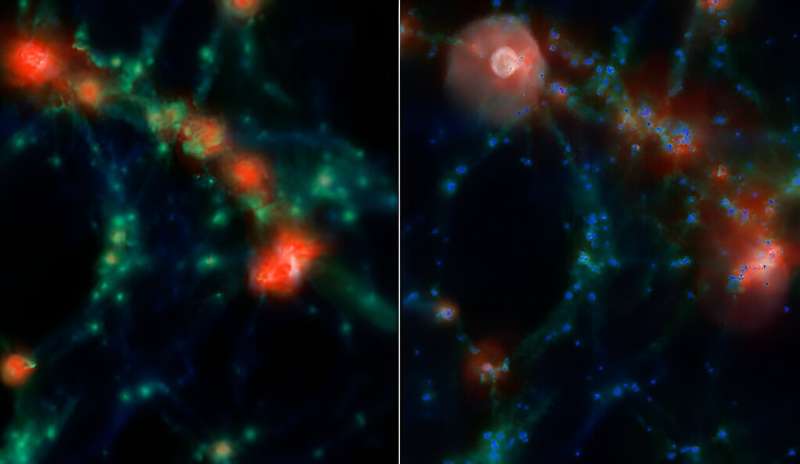This article has been reviewed according to Science X's editorial process and policies. Editors have highlighted the following attributes while ensuring the content's credibility:
fact-checked
peer-reviewed publication
trusted source
proofread
Astronomers find galaxies in denser environments are as much as 25% larger than those in less dense regions

A team of astronomers using a Yale supercomputer have determined for the first time that galaxies in denser environments are as much as 25% larger than their counterparts in less dense regions of the universe.
The finding, which emerged from the researchers' previous development of a massive catalog of the shapes and sizes of 8 million galaxies, offers a comprehensive look at the connection between a galaxy's structure and the environment in which it exists.
The discovery may also provide a useful new tool for analyzing large data sets from the next generation of astronomical surveys, the researchers say.
"This is an important step in resolving decades of contradictory results on this topic," said Aritra Ghosh, a former Yale doctoral student who is now a LSST-DA Catalyst postdoctoral fellow at the University of Washington and lead author of a new study in the Astrophysical Journal. Ghosh is also a visiting research affiliate at Yale.
The new findings were made possible by the Galaxy Morphology Posterior Estimation Network (GaMPEN), a machine-learning tool the research team developed specifically to quickly process large volumes of astronomical imaging data. GaMPEN also estimates uncertainties for the structural parameters of the galaxies it predicts. It is roughly 60% more accurate in this regard than state-of-the-art alternatives currently in use by astronomers, the researchers said.
GaMPEN can determine the structure of a single galaxy in less than a millisecond.
Using the tool, the researchers created a catalog of the shapes and sizes of 8 million galaxies found in the Hyper Suprime-Cam Subaru Strategic Program, a survey of 1,400 square degrees of the sky taken by the Subaru Telescope in Hawaii. This work appeared in a study in the Astrophysical Journal in 2023.
"We publicly release all of our machine-learning models and catalogs," Ghosh said. "This is an incredibly valuable asset, as the structure of galaxies has been found to be intricately linked to a wide variety of physical properties of a galaxy and its surroundings, such as the rate at which stars form, the presence and activity of supermassive black holes, and a galaxy's environment."
"Our machine learning approach is ideally suited to today's enormous surveys, and our first paper was unique in providing quantitative measurements and uncertainties, not to mention analysis of 8 million galaxies," added Meg Urry, the Israel Munson Professor of Physics and Astronomy in Yale's Faculty of Arts and Sciences and co-author of both studies. Urry, director of the Yale Center for Astronomy & Astrophysics, was Ghosh's Ph.D. supervisor.
The team's new study uses GaMPEN to begin answering complex, essential questions about how galaxies form and evolve.
The study, which focused on a subset of 3 million Hyper Suprime-Cam galaxies, found that galaxies in denser parts of the universe are as much as 25% larger than galaxies with a similar mass and shape in less dense regions.
"We can do this because our sample is 100 to 10,000 times larger than all previous studies and incorporates much fainter galaxies than previous studies were able to include," Ghosh said. "We show that while existing theoretical frameworks can explain some of the observed correlations, there is no single, unified framework that can explain all of our results."
The finding is also important, the researchers said, because the structure of galaxies is a proxy for the distribution of baryonic matter (protons, neutrons, and other visible matter), while the environmental density of galaxies is influenced by the distribution of dark matter halos in which galaxies live.
"Galaxies evolve over time, and their properties depend on mass, size, and other variables," Urry said. "By analyzing very large samples, disaggregated by these variables, we were able to detect the increase in galaxy size with environmental density—something that was not clear from smaller studies."
The researchers said they also benefited from a fair amount of "Grace"—that is, a cluster of networked Yale computers operated by the Yale Center for Research Computing and named for the late Grace Murray Hopper, who was a pioneering Yale computer scientist and rear admiral in the U.S. Navy.
"This work was carried out entirely on Grace, and would have been impossible without it," Ghosh said.
More information: Aritra ঘোষ Ghosh অরিত্র et al, Denser Environments Cultivate Larger Galaxies: A Comprehensive Study beyond the Local Universe with 3 Million Hyper Suprime-Cam Galaxies, The Astrophysical Journal (2024). DOI: 10.3847/1538-4357/ad596f
Journal information: Astrophysical Journal
Provided by Yale University





















